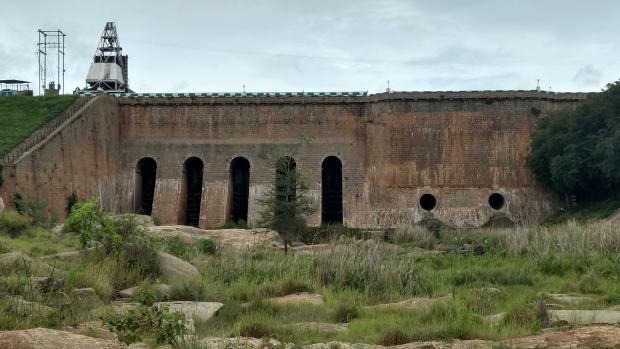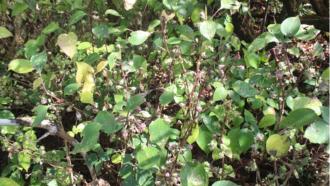
Photo : Sudhira H. S. / Research Matters
Hydrological barriers like dams cause a dramatic decrease in fish diversity, and also make river waters unsuitable for life by decreasing oxygen levels, finds a recent study. The decrease in the fish species diversity is restored only when the rivers are fed unpolluted, undammed waters from tributaries downstream of the barrier.
There are two scenarios in which hydrological barriers may be constructed across rivers, one is to exploit the energy generating potential of the river (through hydroelectric power), and according to the Ministry of Power, only 26% of India’s hydropower potential has been exploited so far. The other reason for building hydrological barriers is to divert water from some rivers to water deficient areas. It is highly likely, therefore, that more hydrological barriers will probably be constructed across the many rivers in our country. This being the case, it is critical that an assessment of the impacts of existing barriers is carried out. An important aspect that needs to be taken into consideration is the impacts of hydrological regulation on the fish species that dwell there, the manner in which they can be mitigated so as to have an informed understanding of how to proceed with more projects of this nature.
In order to acquire a case-specific understanding of the impacts of hydrological barriers on fish species, a recent study from ATREE (Ashoka Trust for Research in Ecology and the Environment), Bangalore, assesses the effects of small and large scale hydrological barriers (check dams, temporary impoundments and barrages) on the fish species diversity in the upper basin of the Malaprabha river, in the Western Ghats. Dr. Atkore, the lead researcher of this paper explains the importance of this study, “the Western Ghats harbors > 64% endemic fish diversity. In fact, most of them are situated in the headwater regions of the river basin/s. These are also important sites for hydropower projects! Mapping endemic species in each river basin is highly important for prioritizing their conservation which alone will enable us to safeguard their population in the near future. Availability of such data to the policymakers would help them focus on some of the key indicator species or an entire aquatic community for long term monitoring.”
The authors compare the fish species diversity in undammed parts of the river, to the stretches of the river which are downstream of dams (with similar elevation and other microhabitat characteristics). In doing so, the authors have employed a simple method through which the effect of hydrological barriers on freshwater fish species composition can be easily assessed and have developed a metric for assessing fish species recovery. The study finds that immediately downstream of a hydrological barrier, the proportion of fish species reduces drastically (which is referred to as ‘fish species recovery’). What is also noteworthy is that the dissolved oxygen content decreases, and the alkalinity of the water increases immediately downstream of the barrier. Sampling further downstream of the barrier, the authors found that after a certain distance, the proportion of fish species does eventually recover substantially and is more similar to that seen in the undammed regions. This recovery is accompanied by an increase in the dissolved oxygen content and a reduction in the alkalinity of the river water.
An important factor leading to the recovery of the species diversity was found to be the number of undammed tributaries which join the river downstream of the dam. As these tributaries currently do not have any barriers themselves, they presumably contain optimum conditions for the survival of a greater number of species, and eventually contribute to the recovery of the species composition in the river. “Surface flow due to the contribution of joining of undammed tributaries seems to have increased DO (Dissolved Oxygen) and reduced alkalinity away from barriers”, says Dr. Atkore.
The study also noted that fish species which showed which did not recover in numbers were those with low swimming ability, and lived at the bottom of the river. Do the authors think that these barriers are imposing some form of artificial selection against species from certain ecological niches, possibly leading to local extinction? “Quite likely!”, says Dr. Atkore, “many of these barriers have clearly fragmented fish habitat and their population. Headwater fishes are very specialised in their habitat, diet and local environmental preferences therefore they have very restrictive ranges (Example includes fishes like – Bhavania sp, Glyptothorax, Barbodes, Tor etc). Any hydrological regulation would impact their movement, fragmenting the genetic flow between population, reducing feeding and spawning habitats, thereby putting them closer to extinction.”
The main takeaway from this study is that the recovery of fish species composition takes place satisfactorily as long as there are a few undammed tributaries which join the river downstream of the dam. This can inform policy-makers in two ways, one of which is to make sure that there is a strict regulation on constructions on undammed tributaries which join dammed rivers. This will ensure that the negative impact of the barrier on the river is mitigated. Another very crucial point to keep in mind before constructing dams on rivers is to ensure that as far as possible, dams are constructed only where there are a few such undammed tributaries which join the river downstream of the dam. Overall the result of the study is particularly important for freshwater conservation planning and to evaluate the cumulative biodiversity impacts of river regulation in modified river basins in the tropical regions.
Although the possible impacts of every potential hydrological barrier should be assessed beforehand in a case-specific manner, this study helps provide general guidelines to follow, especially in the Western Ghats region where increasing demands for water diversion to cities make the construction of dams inevitable.






